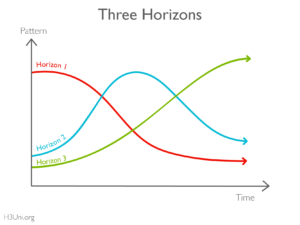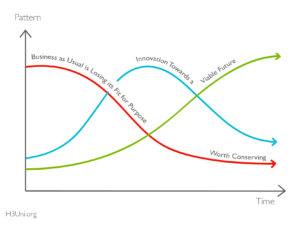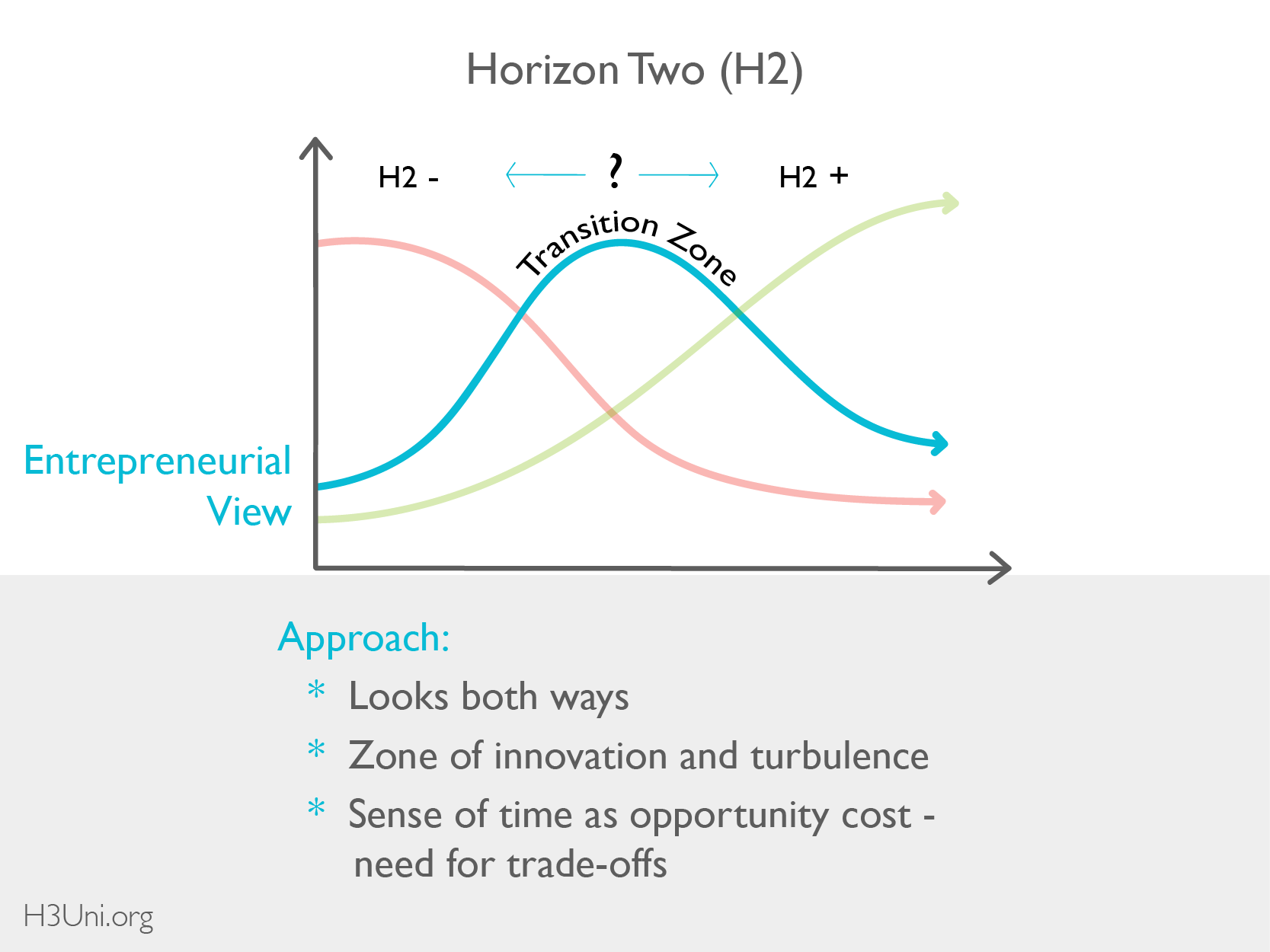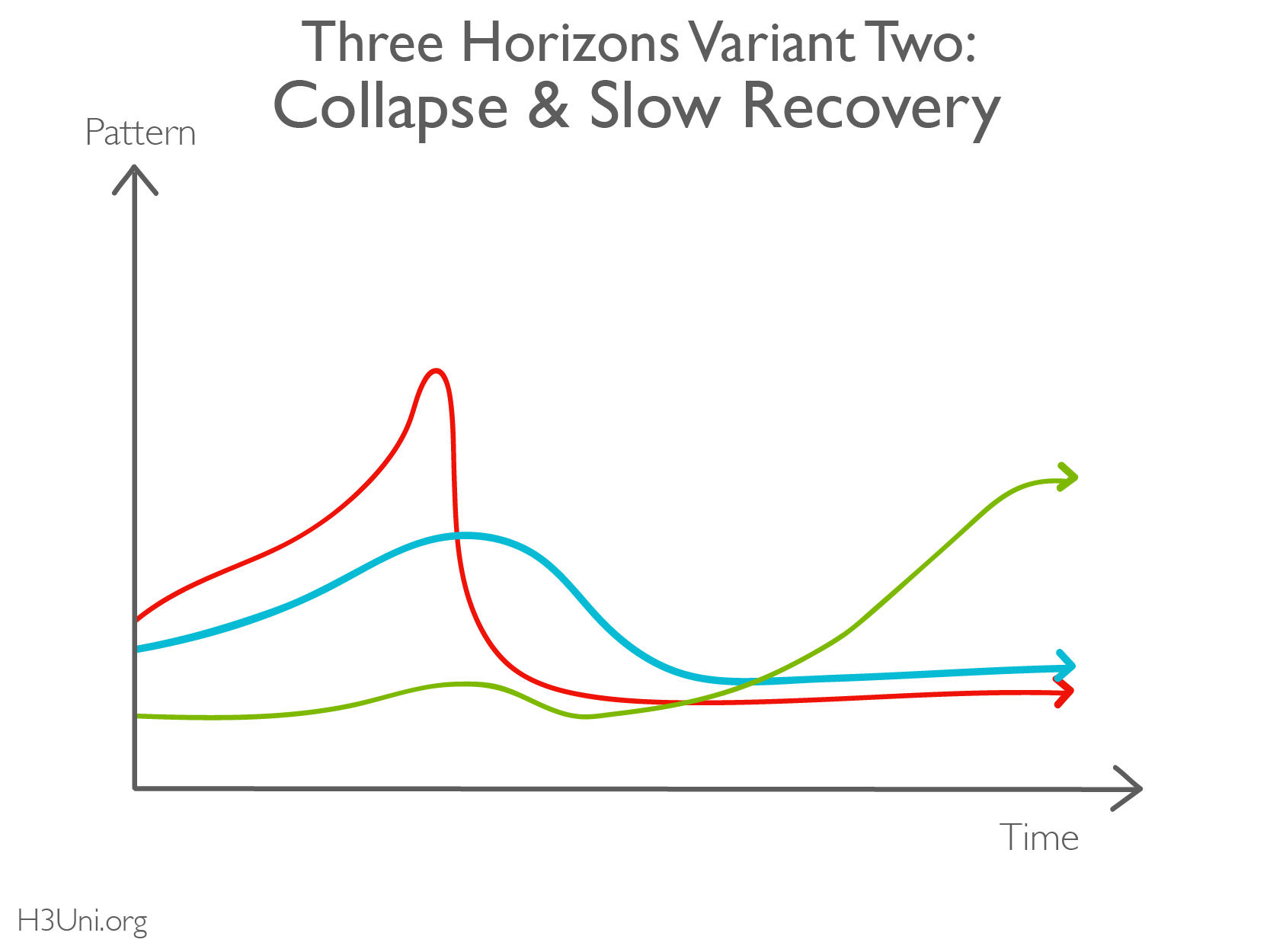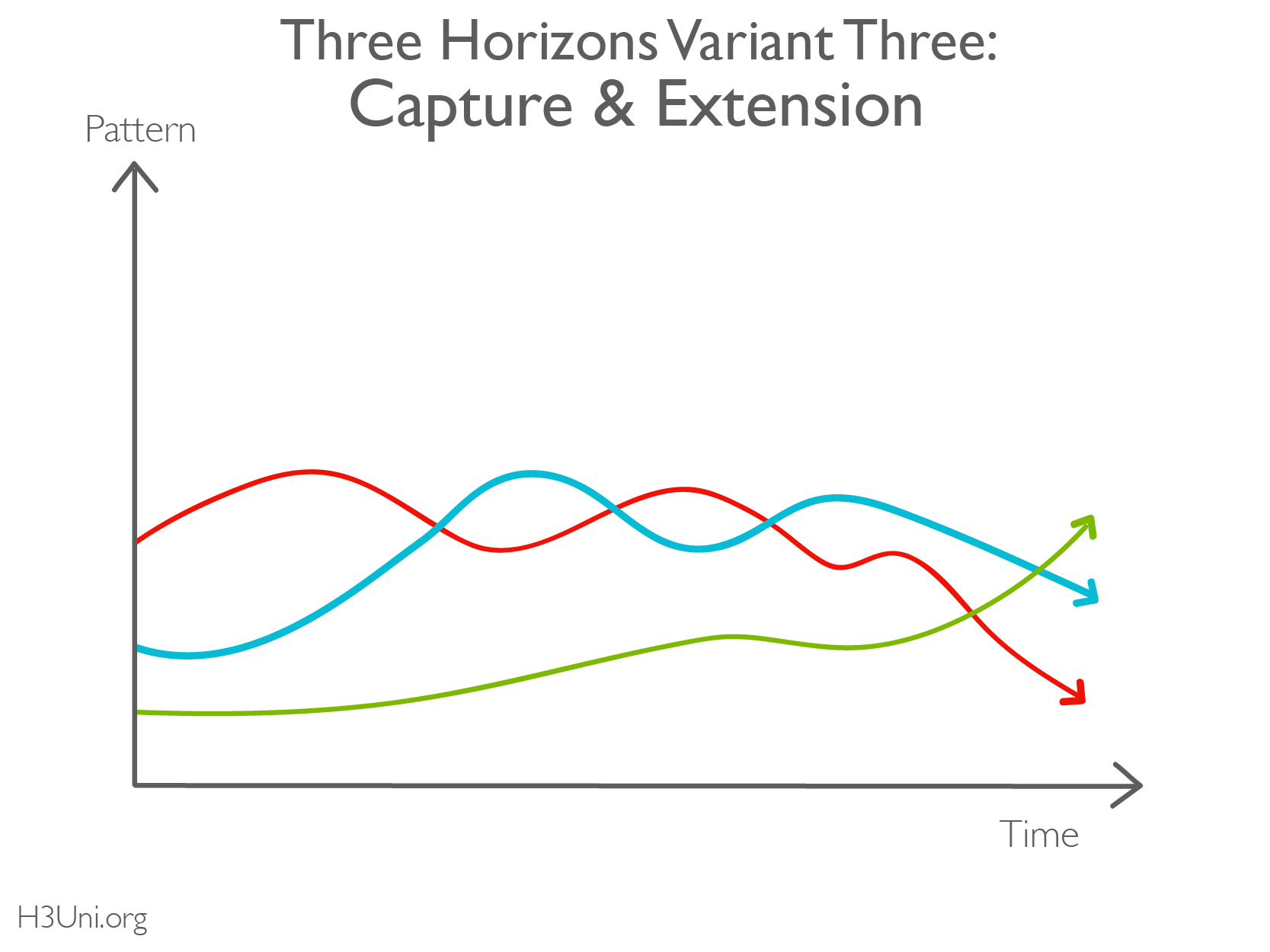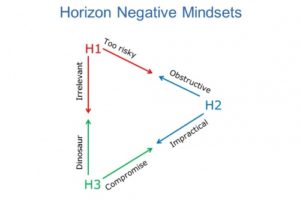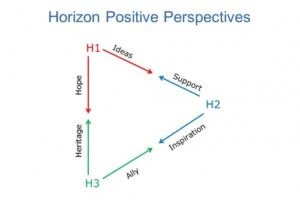Tutorial
Three Horizons
There is a seeming paradox in futures thinking. On the one hand, it is quite difficult and not very common as either method or skill. On the other hand, it is a natural function of the mind and parts of the brain are dedicated to it, sometimes called ‘memory of the future’; we call this natural capacity future consciousness.
The task of facilitating futures thinking is to ease the difficulties and release the natural capacity. That is what the methods explained here enable you to do.
One set of blockages to future consciousness, especially sharing it, is various social habits and taboos that inhibit its function through customs, language and dominant social expectations. Another is the psychology of certainty and uncertainty. Exploratory future thinking includes facing uncertainty in ways that most people try and avoid. This will show itself in denial and avoidance of questions. It will also appear as arguments of the form “Don’t be ridiculous, that could never happen” or “No way! That isn’t possible”. Another factor is around power and security. Nobody likes to consider a future which removes their power position or livelihood. However, in a radically changing world it may be prudent to anticipate such events and prepare contingency plans
The Three Horizons method helps get around some of these difficulties by providing a context in which people can legitimately share different perspectives both amongst each other and internally in their own minds. You will see this later in the section on three voices.
The important skill and capacity of the facilitator is to be able to hold the mental and emotional space for people to be safe in exploring these things. It is also to ensure that “all voices are heard” in the process of building the three horizon map. This means that you, the facilitator, need to have practised three horizons thinking and developed your own future consciousness to have the confidence to carry this through.
Having said that, wide experience by many practitioners in many situations has shown that it has a sort of power to “do itself”, at least at a basic level, if you set up the structure and follow the facilitation protocols.
Patterns of Change
The three horizon model gives us a deeper understanding of the significance of what we usually call short, medium and long term futures. The model is based on the observation that businesses, technologies, political policies and even whole civilizations exhibit life-cycles of initiation, growth, peak performance, decline and even death. These cycles can be viewed as waves of change in which a dominant form is eventually overtaken and displaced by another.
This pattern also shows up in our personal lives where we go through a change of life that is not an extension of the past but has a quite new pattern emerge. In this process we go through a disruptive crisis of transition and transformation.
These displacements may be gradual but, in times of rapid change, they can be quite abrupt. For example, we speak of disruptive technologies that suddenly reach a tipping point and take over the technological ecosystem. However, a closer look reveals that these waves are also going on simultaneously on different scales, changing their place in the foreground or background over time. Yet this is not easy to see unless we appreciate the qualitative differences between the waves. Understanding is further helped by recognising the value of thinking in terms of three waves at a time.
A good way to picture this is to switch from the analogy of waves and think instead in terms of horizons. Imagine you are looking at a view from the plains near the coast towards inland mountains. The first horizon is where the plains end and the foothills of the second horizon rise. Yet behind them are the high mountains of the third horizon. The plains may be agricultural, the foothills wooded and the mountains without trees and with glaciers. Each horizon is qualitatively different. The analogy here is that we need to be able to see different qualities that distinguish the short, medium and long term as more significant than the amount of time. In some areas of society, the three horizons may cover a span of ten years; in others they may span half a century. In other words qualitative or structural change is more significant for strategy than span of time.
We usually label the vertical axis as ‘Pattern’, ‘Viability’, ‘Prevalence’ or ‘Strategic Fit’, which capture the idea of the shift in the most dominant, or prevalent, pattern moving between the horizons over time. It is a reflection of the strategic fit to emerging conditions, and so this is an alternative labelling. Alternatively we can think of the vertical dimension as a scale of a particular condition of interest. For example in the field of sustainability it could be the resilience of a community that falls and rises according to what is going on and the way people live.
H1 - The First Horizon...
… is the dominant system at present. It represents ‘business as usual’. We rely on these systems being stable and reliable but as the world changes, so aspects of business as usual begin to feel out of place or no longer fit for purpose. Eventually business as usual will be superseded by new ways of doing things.
H3 - The Third Horizon...
…emerges as the long term successor to business-as-usual. It grows from fringe activity in the present that introduces completely new ways of doing things but which turn out to be much better fitted to the world that is emerging than the dominant H1 systems. We call these early manifestations “pockets of the future in the present.”
H2 - The Second Horizon...
…is a pattern of transition activities and innovations, people trying things out in response to the ways in which the landscape is changing. Some of these innovations will be taken up by H1 systems to prolong their life while some will pave the way for the emergence of the radically different H3 systems.
Qualities of the Future in the Present
All three horizons are always present, they capture three qualitatively different ways of connecting the present moment to the future.
Aspects of H1 will persist in any new business as usual; aspects of H3 are always evident, if not obvious, in current discourse and argument and in all kinds of activity on the fringes of the dominant system; while H2, like a moving border between past and future, is all around us in examples of innovative alternative practice.
However, the First Horizon’s commitment is to survival. As the current, dominant, system it maintains its dominance, even in a changing world, either by crushing Second and Third Horizon innovation (variant 1 below), or by co-opting it to support its established system (variant 2). This resistance to change impacts on the transition to H3: often it leads to the innovations in H2 being ‘mainstreamed’ in order to prolong the life of the existing system, rather than to help movement towards a new system.
Common Variants
The three line diagram used so far here is what we might call the standard version which is useful for introducing the concept as a framework for facilitation. However, as a model of the way the future unfolds it is only one form. Indeed, it is rather an ideal form for where a shift of pattern is relatively successful and without difficulties other than the deconstruction and reconstruction that is unavoidable in Horizon 2. There are different variants that show that it is useful to bear in mind for more advanced applications, or to point out to people that change into the future is not always straightforward. The standard and three additional variants are shown here:
- Challenge and Transformation
- Collapse and Slow Recovery
- Capture and Extension
- Overshoot & Collapse
Bear in mind that these are just archetypes and the real world is always going to be a messy mixture. The point is not to impose them on a situation, but to use them to sensitise our perception to what is actually going on, and the dynamics in play.
Variant 1: Challenge and Transformation
Horizon 1 is a current strategy that works well until changes in the environment plus its own diminishing returns put it on a curve of decline. Meanwhile Horizon 2, aware of this, is innovating more effective approaches which eventually overtake.
In the background, a completely new paradigm is emerging as Horizon 3. It appears for a long time to be marginal and ineffective but since it matches better the new environment it eventually takes over. The Horizon 2 innovations have served as enabling to the transformation.
Variant 2: Collapse and Slow Recovery
In this variant the supremacy of the Horizon 1 paradigm creates runaway success but at the expense of some critical condition. Failure to capture coupled with weaker innovation in Horizon 2 leads to sudden collapse. Horizon 2 is unable to make up for this.
In the background Horizon 3 continues to develop and after the initial upset and chaos of the collapse demonstrates its ability to match the new conditions and emerges as the next viable paradigm.
Examples: Many city and region economies have been through this cycle due to their strong commitment to a particular industry that has lost competitiveness e.g. autos, steel, textiles.
Variant 3: H1 Capture and Extension
Horizon 1 is challenged by changing conditions and there is strong innovation opportunity taken by Horizon 2. However, each wave of innovation is captured by Horizon 1 and applied to extend its life. This may go on for several cycles.
Horizon 3 remains in the background since it is so different from Horizon 1 that there is no place for it in the mainstream. It continues to languish in the margins until a much more fundamental and long term change occurs.
Examples: financial crises (e.g.2008) show a breakdown in the Horizon 1 business-as-usual and there is clamour for fundamental reform. However, the dominant system pushes back and only minor adjustments are made (e.g. quantitative easing, regulatory reform). Meanwhile the underlying structural problem still persists leading inevitably to a series of crises and fixes. New financial structures and currencies languish in the background as Horizon 3 possible solutions. Entrepreneurial attempts are made for alternatives that might be on the path to H3 or sustain and extend H1.
Variant 4: H2 Overshoot
H1 is challenged by a compelling vision that is hyped up and creates a wave of investment in Horizon 2 innovations. This creates a boom followed by bust as many innovations are poorly judged.
Horizon 3, which was the source of the vision gets a boost from the Horizon 2 over-investment, and grows strongly as confidence returns and the vision matures.
Examples: Technologies are often over-hyped by their protagonists in order to attract funding, but are then not able to fully absorb that investment if a boom takes off. The Dotcom bust was a major example.
Mindsets and Perspectives
The effectiveness of Three Horizons comes from recognising that the three horizons are not just abstract representations of change, but characterise three qualitatively different orientations to the future in the present – they describe ways people are behaving to maintain the first horizon or seeking to change it. We referred to this earlier as “three voices”.
The interaction between the horizons is as much culturally determined as it is economic or technologically determined. The people and groups associated with each horizon at a given point in time have very different interests, values and mindsets. This makes communication difficult and the tendency for misunderstanding and conflict very high. Indeed, there is competition between the horizon mentalities and in some cases outright conflict. This is why we more often than not see Variants 2 and 3 rather than the smother transition of the Variant 1.
However, in managing transformational change, where we want to avoid the costs of conflict or collapse, it is necessary to develop a perspective that understands all three mindsets and takes them into account. The challenge for transformational leadership is to be able to stand back from an overall position to be able to see the interplay between them, and work with them all constructively – we call this the step into future consciousness. This is most easily studied as the kinds of attitudes and judgements that people from each of the horizons make about each other and each other’s activities and priorities.
All three mindsets are present in the situation simultaneously, either isolated or in conflict. The facilitation task is getting them to talk to each other and work towards collaborative transition for transformation. The initial stances of each mindset towards the others is caricatured in the above diagram on the left. On the right are how these negative mindsets can be transformed into positive perspectives.
In the facilitation role it is helpful to listen to people’s contributions and conversations with the two triangles in mind and see if you can spot entrenched positions and therefore encourage the co-operative relationship between the voices.
Convening the Future
The Three Horizons model offers a simple way into a conversation about:
- the dominant system and the challenges to its sustainability into the future, ie the case for change (Horizon 1);
- the emerging future state or the imagined system of which we can identify elements in the present that provide encouragement and inspiration (Horizon 3);
- the nature of the tensions and dilemmas between H3 visions and H1 reality, and the subtle processes of change, new ways of working, new capacities, new structures even, required to navigate the transition between them;
- the requirement to develop a mature perspective that accepts the need both to address the challenges to the First Horizon and nurture the seeds of the Third. This is not an either/or, good/bad discussion. We need both to ‘keep the lights on’ today, and to find a way of keeping them on in the future in very different circumstances.
We typically introduce the horizons, and think about the way the dynamic changes between them over time, in this order: H1 – H3 – H2. This is because without a third horizon it is impossible to make the distinction between ‘sustaining innovation’ (H2-) and ‘transformative innovation’ (H2+).
Starting with the first horizon brings into view why the conversation is happening, why it is felt that the current ‘business as usual’ can no longer make the changes needed. Moving to the third horizon we talk about our own visions but also all the other alternative and competing views of the future of which we are aware. This is a chance to surface underlying assumptions and different value systems, and where power to shape the future lies. Real examples populate the ‘pockets of the future’. A deeper enquiry into uncertainty can use scenario approaches to develop alternative stories of how the future context might turn out that we will need to adapt to.
In the second horizon we identify initiatives underway and how they relate to sustaining and transformative change. As we develop the third horizon picture more then we can also start to see the role of the first horizon in the future. Usually, once we have been able to let go of it and move to the third horizon we find there are important things that must not be lost and can be adapted to the new environment.
Bringing all three horizons together as an interrelated pattern and as a shared narrative of possibilities for navigating towards the chosen better future, is a crucial practical result of cultivating future consciousness through convening the future.
Methods
There are three method Facilitation Guides for Three Horizons:
- Three Horizons Mapping: this is the basic process of building a Three Horizon map of any topic.
- Three Horizons Multi-Actor Mapping: this broadens the mapping process to combine multiple viewpoints on the emerging H3. It is a good way to combine the vision of the group with other sources of change that need to be taken into account.
- Three Horizons Action Planning: this takes the output of the Mapping method and structures action towards a desired H3 vision.
Dilemma Navigation provides a more advanced method of developing visionary and adaptive pathways that retain essential values of H1 while moving towards the H3 vision. Further methods for this, and for Navigational Scenarios are coming soon.
Resources
Further resources including a set of introductory videos, links to organisations using Three Horizons, and case studies at www.futurestewards.com
The International Futures Forum has an extensive set of resources for learning and practice at: www.iffpraxis.com/three-horizons
References
The first published version of a three horizons model was in Baghai, M., Coley, S. and White, D.S. The Alchemy of Growth: Practical Insights for Building the Enduring Enterprise. Orion Business, (1999).
The development of the Three Horizons method as presented here is described in Curry, A., and A. Hodgson. Seeing in Multiple Horizons: Connecting Futures to Strategy. Journal of Futures Studies 13, no. 1: 1–20 (2008)
Deeper theory based on the work of Anthony Hodgson on the Anticipatory Present Moment in Sharpe, B., Hodgson, A. Anticipation in Three Horizons. In: Poli, R. (eds) Handbook of Anticipation. Springer, Cham. (2019)
The positioning of Three Horizons as a pathways practice for transformative change, in relation to futures practices of scenarios and roadmaps is described in Sharpe, B., G. Leicester, A Hodgson, A. Lyon, and I. Fazey. Three Horizons: A Pathways Practice for Transformation. Ecology and Society, vol. 21, no. 2, (2016).
Further development and explanation of the variants in Fazey, I., and G. Leicester. Archetypes of system transition and transformation: Six lessons for stewarding change. Energy Research and Social Science 91 (2022)
The overall approach is described in the book Sharpe, B.,. Three Horizons: The Patterning of Hope. London: Triarchy Press, (2013).
Further references
Peer-reviewed journal articles
Bina O, Baptista MD, Pereira MM, et al (2024) Exploring desired urban futures: the transformative potential of a nature-based approach. Futures 159:103362. https://doi.org/10.1016/j.futures.2024.103362
Hines A, Benoit H, Leong L, et al (2024) Mapping archetype scenarios across the three horizons. Futures 162:103418. https://doi.org/10.1016/j.futures.2024.103418
Matovu B, Alkoyak-Yildiz M, Lukambagire I, et al (2024) Using a systems thinking approach to increase coastal community resilience against environmental shocks: A case study of Valiathura coastal area, India. Acta Sci Pol 23:3–18. https://doi.org/10.15576/asp.fc/2024.23.1.01
Taimur S, Luederitz C, Gauthier M, et al (2024) Theorizing how the Three Horizons approach supports transformative learning: insights from advancing climate action in a Canadian Biosphere Reserve. Ecol Soc 29. https://doi.org/10.5751/es-15099-290218
Uyttewaal K, Stoof CR, Canaleta G, et al (2024) Uplifting local ecological knowledge as part of adaptation pathways to wildfire risk reduction: A case study in Montseny, Catalonia (Spain). Ambio 1–21. https://doi.org/10.1007/s13280-024-02030-7
Adams D (2023) The Future of Sport and Recreation in New Zealand. J Futures Stud 28:63–79. https://doi.org/10.6531/JFS.202309_28(1).0006
Bachi L, Corrêa D, Fonseca C, Carvalho-Ribeiro S (2023) Are there bright spots in an agriculture frontier? Characterizing seeds of good Anthropocene in Matopiba, Brazil. Environ Dev 46:100856. https://doi.org/10.1016/j.envdev.2023.100856
Collste D, Aguiar APD, Harmáčková ZV, et al (2023) Participatory pathways to the Sustainable Development Goals: inviting divergent perspectives through a cross-scale systems approach. Environ Res Commun 5:055014. https://doi.org/10.1088/2515-7620/acce25
Mauno T, Catelo F, Bengston DN, et al (2023) How to identify and interpret weak signals of change in the forest bioeconomy. For Policy Econ 157:103075. https://doi.org/10.1016/j.forpol.2023.103075
Stewart I, Capello MA, Mouri H, et al (2023) Three Horizons for Future Geoscience. Earth Sci Syst Soc 3. https://doi.org/10.3389/esss.2023.10079
Schaal T, Mitchell M, Scheele BC, et al (2023) Using the three horizons approach to explore pathways towards positive futures for agricultural landscapes with rich biodiversity. Sustain Sci. https://doi.org/10.1007/s11625-022-01275-z
Adams D (2023) The Future of Sport and Recreation in New Zealand. J Futures Stud 28:63–79. https://doi.org/10.6531/JFS.202309_28(1).0006
Barnert E, Wright J, Choi C, et al (2022) Reimagining Children’s Rights in the US. JAMA Pediatr 176:1242–1247. https://doi.org/10.1001/jamapediatrics.2022.3822
Facer K (2022) Imagination and the future university. Crit Times 5:202–216. https://doi.org/10.1215/26410478-9536559
Facer K, Newfield C (2022) Introduction: The University at the End of the World. Critical Times 5:78–86. https://doi.org/10.1215/26410478-9536484
Fazey I, Leicester G (2022) Archetypes of system transition and transformation: Six lessons for stewarding change. Energy Res Soc Sci 91:102646. https://doi.org/10.1016/j.erss.2022.102646
Field A (2022) Mining the ambient commons: building interdisciplinary connections between environmental knowledge, AI and creative practice research. Interdiscip Sci Rev 47:185–198. https://doi.org/10.1080/03080188.2022.2036408
Gavroglu K (2022) University rankings. Crit Times 5:121–128. https://doi.org/10.1215/26410478-9536519
Harmáčková ZV, Blättler L, Aguiar APD, et al (2022) Linking multiple values of nature with future impacts: value-based participatory scenario development for sustainable landscape governance. Sustain Sci 17:849–864. https://doi.org/10.1007/s11625-021-00953-8
Jiren TS, Riechers M, Kansky R, Fischer J (2021) Participatory scenario planning to facilitate human–wildlife coexistence. Conserv Biol 35:1–9. https://doi.org/10.1111/cobi.13725
Kuiper J, Wijk D, Mooij W, et al (2021) Exploring desirable nature futures for Nationaal Park Hollandse Duinen. Ecosyst People 18:329–347. https://doi.org/10.1080/26395916.2022.2065360
Aguiar APD, Collste D, Harmáčková ZV, et al (2020) Co-designing global target-seeking scenarios: A cross-scale participatory process for capturing multiple perspectives on pathways to sustainability. Glob Environ Change 65:102198. https://doi.org/10.1016/j.gloenvcha.2020.102198
Heij G (2016) Anybody out there? The Future of Tax. J Futures Stud 21:35–50 https://jfsdigital.org/2016-2/vol-21-no-2-dec-2016/articles/anybody-out-there-the-future-of-tax/
Conference papers
Hodgson A, Midgley G (2015) Bringing foresight into systems thinking: A three horizon approach. In: 58th Annual Meeting of the International Society for the Systems Sciences, ISSS 2014 https://h3uni.org/wp-content/uploads/2016/11/bringing_foresight_into_systems_thinking.pdf
Book chapters
Renouard C (2023) Transformation. In: Wallenhorst N, Wulf C (eds) Handbook of the Anthropocene: Humans between Heritage and Future. Springer International Publishing, pp 1327–1331
Sharpe B, Ash-Harper, Z (2022) Producing Inclusion with Three Horizons. In Koenig O (ed) Inklusion und Transformation in Organisationen. Julius Kilinhardt, pp 41-64 https://library.oapen.org/handle/20.500.12657/60338
Sharpe B, Hodgson A (2019) Anticipation in Three Horizons. In: Poli R (ed) Handbook of Anticipation: Theoretical and Applied Aspects of the Use of Future in Decision Making. Springer Verlag, Heidelberg, pp 1071–1088
Lyon A (2018) Three horizons of general practice. In: Watt G (ed) The Exceptional Potential of General Practice: Making a Difference in Primary Care. CRC Press, Boca Raton, FL, pp 5–8
![]()
Creative Commons Attribution-ShareAlike 4.0 International (CC BY-SA 4.0) license framework.
How to Use this License
CC BY-BY-SA
This license allows reusers to distribute, remix, adapt, and build upon the material in any medium or format, so long as attribution is given to the creator. The license allows for commercial use. If you remix, adapt, or build upon the material, you must license the modified material under identical terms.
Read about Open Access to H3Uni Methods and Materials
